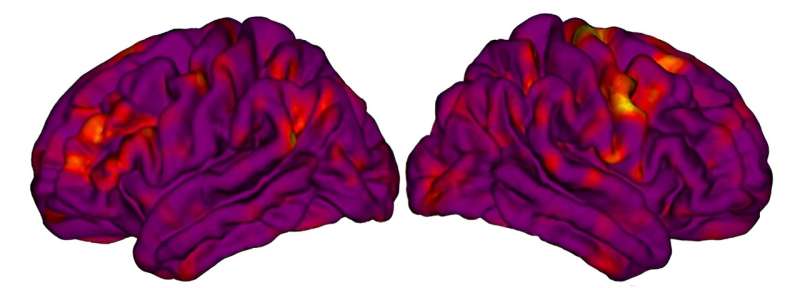This article has been reviewed according to Science X's editorial process and policies. Editors have highlighted the following attributes while ensuring the content's credibility:
fact-checked
peer-reviewed publication
trusted source
proofread
Researchers find key differences in brain development between autistic boys and girls

A new study led by UC Davis researchers finds widespread differences in brain development between autistic boys and girls ages 2–13. The study, published recently in Molecular Psychiatry, found sex-specific changes in the thickness of the outer layer of the brain, called the cortex.
The findings are notable because so few studies have addressed cortical development in autistic girls, who are diagnosed with autism less often than males. Nearly four males are diagnosed with autism for every one female.
"It is clear that this sex bias is due, in part, to underdiagnosis of autism in females," said Christine Wu Nordahl, a professor in the Department of Psychiatry and Behavioral Sciences and the UC Davis MIND Institute and a senior author on the paper. "But this study suggests that differences in diagnosis are not the full story—biological differences also exist."
The brain's outer layer, the cortex, is made up of distinct layers comprised of millions of neurons. These fire in sync together, allowing us to think, learn, solve problems, build memories, and experience emotions. Until about age 2, the cortex rapidly thickens as new neurons are created. After this peak, the outer cortical layer thins. Previous studies have found that this thinning process is different in autistic children than non-autistic children, but whether autistic boys and girls share the same differences had not been examined.
"It's important to learn more about how sex differences in brain development may interact with autistic development and lead to different developmental outcomes in boys and girls," explained Derek Andrews, lead author on the study and an assistant project scientist in the Department of Psychiatry and Behavioral Sciences and at the MIND Institute.
A changing cortex in childhood
The research team studied the brain scans of 290 autistic children—202 males and 88 females, and 139 non-autistic, typically developing individuals—79 males and 60 females. They used sex assigned at birth to categorize the children.
All were participants in the MIND Institute's Autism Phenome Project (APP), one of the largest longitudinal autism studies in the world. The project includes the Girls with Autism Imaging of Neurodevelopment (GAIN) study, launched to increase the number of females represented in research. The researchers took MRI (magnetic resonance imaging) scans at up to four time periods between the ages of 2 and 13.
They found that at age 3, autistic girls had a thicker cortex than non-autistic girls of the same age, comprising about 9% of the total cortical surface. Differences in autistic males when compared to non-autistic males of the same age were much less widespread.
In addition, when compared to males, autistic females had faster rates of cortical thinning into middle childhood. The cortical differences were present across multiple neural networks.
"We found differences in the brain associated with autism across nearly all networks in the brain," Andrews said.
He noted that it was a surprise at first that the differences were greatest at younger ages. Because autistic girls had a more rapid rate of cortical thinning, by middle childhood, the differences between autistic males and females were much less pronounced.
"We typically think of sex differences as being larger after puberty. However, brain development around the ages of 2-4 is highly dynamic, so small changes in timing of development between the sexes could result in large differences that then converge later," Andrews explained.
The importance of long-term studies of both sexes
These findings make it clear that longitudinal studies that include both sexes are necessary, Nordahl said.
"If we had only looked at boys at age 3, we may have concluded that there were no differences. If we had both boys and girls, but only investigated differences at 11 years of age, we may have concluded that there were very few sex differences in the cortex. We needed to follow both boys and girls across development to see the full picture," she explained.
This was why Nordahl, who now directs the APP, launched the GAIN study in 2014. "The APP had a wonderfully large sample of about 150 autistic boys, but only about 30 autistic girls. This was too few autistic girls to really examine how they might be similar or different to boys, so we worked to increase the representation of autistic females in our research," she said.
GAIN is unique, and Andrews said he hopes other researchers will follow suit in including more autistic girls in autism research. "Autistic females represent about 20% of the autistic population. Any successful effort to understand autism will need to include autistic females."
Co-authors on the study include Kersten Diers and Martin Reuter of the German Center for Neurodegenerative Diseases; Devani Cordero of Massachusetts General Hospital; and Joshua K. Lee, Danielle J. Harvey, Brianna Heath, Sally J. Rogers, Marjorie Solomon, David Amaral and Christine Wu Nordahl of UC Davis.
More information: Derek S. Andrews et al, Sex differences in trajectories of cortical development in autistic children from 2–13 years of age, Molecular Psychiatry (2024). DOI: 10.1038/s41380-024-02592-8



















